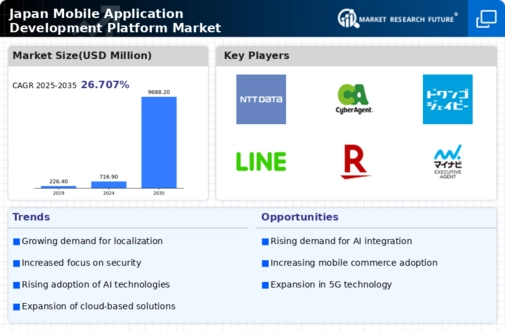Expansion of 5G Technology
The expansion of 5G technology in Japan is set to have a transformative impact on the mobile application-development-platform market. With the rollout of 5G networks, mobile applications can leverage higher speeds and lower latency, enabling more complex functionalities and real-time interactions. This technological advancement opens new avenues for app developers, allowing them to create applications that were previously not feasible. For instance, applications utilizing high-definition video streaming and real-time gaming are likely to flourish in a 5G environment. As the infrastructure for 5G continues to develop, the mobile application-development-platform market is expected to grow, driven by the demand for innovative applications that harness the capabilities of this next-generation technology.
Growing Demand for Mobile Solutions
The mobile application-development-platform market in Japan is experiencing a surge in demand for mobile solutions across various sectors. Businesses are increasingly recognizing the necessity of mobile applications to enhance customer engagement and streamline operations. According to recent data, the mobile app usage in Japan has reached approximately 80% of the population, indicating a robust market potential. This trend is further fueled by the rise of e-commerce and digital services, compelling companies to adopt mobile strategies. As a result, the mobile application-development-platform market is likely to witness significant growth, driven by the need for innovative and user-friendly applications that cater to the evolving preferences of consumers.
Increased Investment in Digital Transformation
In Japan, there is a marked increase in investment towards digital transformation initiatives, which is significantly impacting the mobile application-development-platform market. Organizations are allocating substantial budgets to enhance their digital capabilities, with a focus on mobile applications as a key component of their strategies. Reports indicate that companies are expected to invest over ¥1 trillion in digital transformation by 2025, highlighting the urgency to adopt mobile solutions. This trend is driven by the need to improve operational efficiency and customer satisfaction. Consequently, the mobile application-development-platform market is poised for growth as businesses seek to leverage mobile technologies to stay competitive in an increasingly digital landscape.
Technological Advancements in Development Tools
Technological advancements are playing a pivotal role in shaping the mobile application-development-platform market in Japan. The introduction of sophisticated development tools and frameworks has streamlined the app development process, enabling developers to create high-quality applications more efficiently. For instance, the adoption of cloud-based platforms has facilitated seamless collaboration among development teams, reducing time-to-market for new applications. Furthermore, the integration of advanced features such as augmented reality (AR) and virtual reality (VR) is becoming increasingly feasible, enhancing user experiences. This evolution in development tools is likely to attract more businesses to invest in mobile applications, thereby propelling the growth of the mobile application-development-platform market.
Rising Consumer Expectations for User Experience
Consumer expectations regarding user experience are evolving rapidly in Japan, influencing the mobile application-development-platform market. Users now demand applications that are not only functional but also intuitive and aesthetically pleasing. This shift in expectations compels developers to prioritize user-centric design and seamless navigation in their applications. As a result, businesses are increasingly investing in platforms that enable them to create high-quality user experiences. The emphasis on user experience is likely to drive innovation within the mobile application-development-platform market, as companies strive to meet the sophisticated demands of their customers and differentiate themselves in a crowded marketplace.


















Leave a Comment